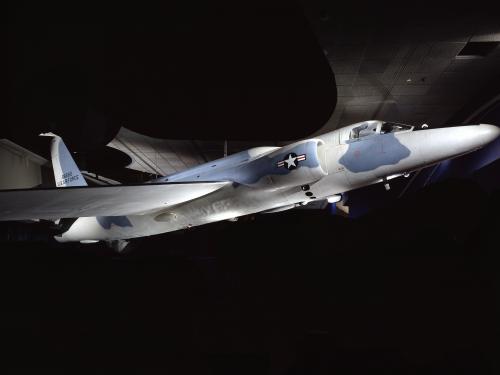
National Air and Space Museum in Washington, DC
Past Exhibition

National Air and Space Museum in Washington, DC
Past Exhibition
The United States possessed no combat-worthy aircraft upon entry into World War I in 1917. Several European aircraft were considered. The British DH-4 was selected because of its comparatively simple construction and its apparent adaptability to mass production. It was also well-suited to the new American 400-horsepower Liberty V-12 engine. American-built DH-4s were dubbed the "Liberty Plane." By war's end, 13 Army Air Service squadrons, five of them bomber squadrons, were equipped with them. In addition, four combined Navy-Marine squadrons were flying DH-4s along the Belgian coast. Of the 4,346 DH-4s built in the United States, 1,213 were delivered to France, but of those only 696 reached the Zone of Advance. In the postwar period, the DH-4 was the principal aircraft used by the U.S. Government when air mail service began in 1918.
The DH-4 in the NASM collection was the prototype American-built DH-4, manufactured by the Dayton-Wright Airplane Company. This airplane was used in more than 2,600 experiments until its retirement in April 1919. On May 13, 1918, Orville Wright made his last flight as a pilot in a 1911 Wright Model B alongside this DH-4, flown by Howard Max Rinehart. He then made a flight as a passenger in the DH-4 with Rinehart.
This object is not on display at the National Air and Space Museum. It is either on loan or in storage.
First Combat Aircraft Mass Produced in the U.S.
The United States had no combat-worthy aircraft upon entry into World War I in 1917. The British DH-4 was selected because of its comparatively simple construction and adaptability to mass production. Over 4,300 were manufactured.
1917-1918
United States of America
CRAFT-Aircraft
Dayton-Wright Airplane Co.
Two-seat, single-engine World War I biplane observation and bomber aircraft; 400-horsepower Liberty V-12 water-cooled engine. American-built version of a British design. Wings and tail natural finish overall. Fuselage light yellow on sides, brown on top.
Wingspan: 13.0 m (42 ft 8 in)
Length: 9.3 m (30 ft 5 in)
Height: 3.2 m (10 ft 6 in)
Weight: Empty, 1,087 kg (2,391 lb)
Gross, 1,953 kg (4,297 lb)
Airframe: Wood
Covering: Fabric
Steel
De Havilland DH-4
A19190051000
Transferred from the U.S. War Department, Bureau of Aircraft Production
National Air and Space Museum
Open Access (CCO)
For more information, visit the Smithsonian’s Terms of Use.